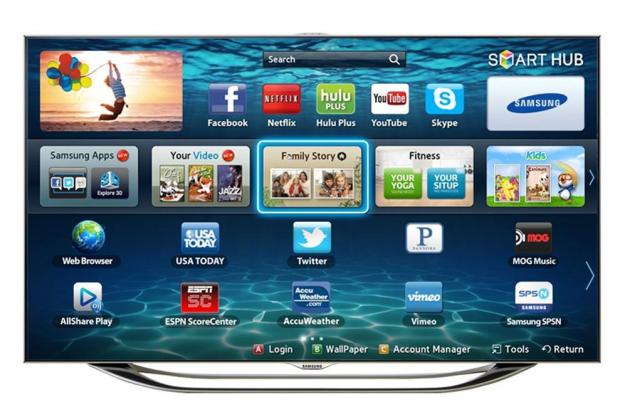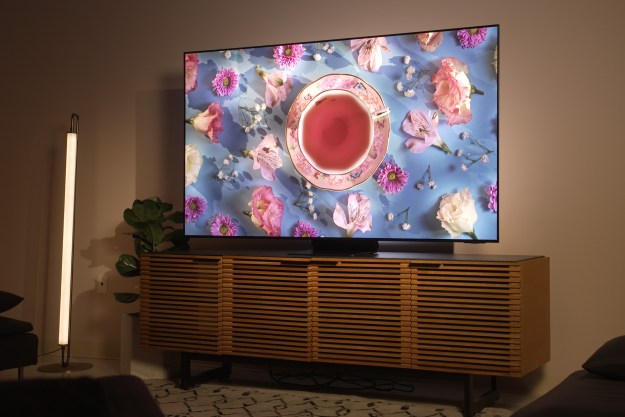
“If you want the best, you’ll have to pay for it, but Samsung’s ES8000 series is certainly one of the best LED televisions we’ve ever seen.”
- Brilliant, bright picture
- Excellent black levels
- Superb color accuracy
- Gorgeous design
- Upgradable hardware
- Some light bleed from edges
- Poor off-axis performance
- Merciless with low-quality sources
Samsung UNES8000 series information: The review for UN46ES8000 is based on our time spent with the 60-inch UN60ES8000 model. According to Samsung, all models in the series (including the 55-inch UN55ES8000 and the 65-inch UN65ES8000) have similar specifications – except for the weight and dimensions – and should offer similar performances.
|
Models in Samsung UNES8000 Series |
Size |
| Samsung UN46ES8000 | 46 inches |
| Samsung UN55ES8000 | 55 inches |
| Samsung UN60ES8000 (reviewed) | 60 inches |
| Samsung UN65ES8000 | 65 inches |
Were it not for the recent U.S. debut of Samsung’s new flagship ES9000 series of LED edge-lit televisions, we’d say that its ES8000 models are the single most advanced televisions you can buy now. Despite Samsung having one-upped itself with the ES9000 series, the ES8000 still stands as one of the most advanced televisions you are likely to consider buying in 2012, considering that the 60-inch model has a street price of around $3,000 whereas the behemoth 75-inch ES9000 will tap your wallet to the tune of about $10,000.
Although considerably less expensive than the ES9000 series, the ES8000 is still a pricey television. The justification seems to lean on the inclusion of Samsung-specific premium features including Smart Interaction (gesture and voice control), Smart Hub (Internet apps and media) and Smart Evolution, which allows the television’s dual-core processor and memory to be swapped out later for higher performance guts. But are these bells and whistles worth the added price, or would the less heavily blinged-out ES6500 or ES7500 series be a better deal? Read on for our take.
Out of the box
If you’ve had a chance to see the ES8000 up close and lay hands on it, you know we’re talking about a 60-inch television that weighs about 45 pounds and is barely an inch thick in most places. Add that to a bezel that is as attractive as it is tiny, and you have one dead-sexy television. Yet there is something to de-boxing this state-of-the-art display that really nails home the fact that this TV is about as badass as they come.
We loved that the television arrived with the stand already installed. Folks who intend to wall mount may feel differently, but for those of us who de-box and repack two televisions a week on average, having the stand already attached is a major bonus.
In the box with the ES8000 we found four pairs of active-shutter 3D glasses, an IR blaster, a touchpad remote, a standard remote and enough batteries to power all parts that require them.
Features and design
The difference between the ES8000 series and the step-down ES7500 – aside from the $400 difference in MSRP — is about as slim as the televisions are themselves. Each series measures about the same dimensions (when comparing like-sized models); both offer an attractive, slim bezel and impressive dynamic contrast ratios. They are both edge-lit with micro-dimming capabilities and all the picture adjustment settings you could wish for. You get four pairs of active 3D glasses with either model. Most notably, both offer a built-in camera with microphone and touchpad remote with microphone, allowing access to Samsung’s Smart Interaction feature, which involves gesture and voice control. So what features define the difference between these two high-end options, and why should you consider spending $400 more for the ES8000?
We found three main differences, two of which are notable enough alone to justify the price hike. The first and least substantial difference is the stand. We’ve been vocal about disliking the “spider stand” included with the ES7500 and other models of Samsung televisions (although recent color changes make it more palatable). So we’re happy to see the new “U-shaped” stand included with the ES8000. We just wish that with the redesign we didn’t lose the option to swivel the stand.

The second difference – and one that isn’t a big deal to us but may be to you depending on how you like your motion smoothing – is in the “clear motion rate” or CMR of the ES7500’s 840Hz vs. the ES8000’s 960Hz. Supposedly, the motion smoothing on the ES8000 is more effective.
The final difference is substantial. The ES7500 offers Samsung’s Micro Dimming Pro, while the ES8000 offers the more advanced Micro Dimming Ultimate. Although the names make the difference sound negligible, the “ultimate” version of this LED backlight-dimming schema involves hardware dimming technology that is omitted in the lesser series. Having compared the two side-by-side, we can attest that the difference in black-level performance will be significant to picky viewers.
As we mentioned earlier, Samsung threw every feature in its arsenal at this television. The feature list is far too long to print here; so if you’d like to feast your eyes on a buffet of specs, you can do so at Samsung’s website on the spec page for the ES8000. With that said, we do want to analyze the two remotes included with the television before moving on.

The television comes with Samsung’s standard remote, which we like. It is similar to the remote we saw included with Samsung’s E6500 plasma television, but with a couple of minute differences. Foremost, it is backlit (an essential feature for us), if only dimly so. The buttons are large and easy to press and the source button is easy to find. Although the remote has no “hot keys” to take you directly to Netflix, Hulu or other popular Internet apps, a nice big button takes you straight to Samsung’s Smart Hub where you can find those apps on the home screen.
The touchpad-style remote is an entirely different device, and we think it may take some getting used to for some people, assuming its functionality resonates with them at all. Actual buttons cover the basics such as power, volume and channel up-and-down, but the rest of the remote operates off of a menu on the television, which the user navigates using the touchpad. The approach works well for those who long for fewer buttons without limited functionality. But as we said, we think folks will need to warm up to this remote. We do like that the touchpad remote works over Bluetooth and requires no line of sight. The additional microphone included in the top is also helpful if you use the television’s voice command features, too.
Setup
Because we didn’t have to fuss with attaching a television stand, we were able to dig into adjusting the television’s picture settings right away. Surprisingly, adjusting the picture settings took little time. We set the television’s picture preset to “movie” and were pleasantly surprised to find that the preset had us more or less dialed in already. We ran through our test patterns anyway, but found that we needed to do very little. Contrast, although maxed out, tested right where it should, and we only needed to knock down the brightness control a few notches to satisfy our tastes. As usual, our recommended settings are listed at the end of this article, but the ES8000’s movie setting is as close to “set it and forget it” as we’ve ever seen.
2D picture performance
Although the ES8000 series is technically no longer Samsung’s flagship LED-backlit television, it was top-of-the-line until just recently; therefore, we had flagship-level expectations going into our evaluations. We were not disappointed.
The ES8000 delivered razor-sharp images with outstanding color accuracy and exceptional brightness. Black levels also were outstanding. We were impressed by the ES8000’s ability to keep display objects in the center of a dark background without causing a “halo” effect. Shadow detail, although weaker than what we’ve seen with Samsung’s plasma televisions, was still well above average.
We played a wide array of content, but we were most impressed while viewing Pixar movie clips from a sampler disc we happened to have on hand. The level of Pixar-generated detail that was exposed is the sort of stuff that gets people oohing and aahing. This set delivers the “wow-factor” in spades.
Performance in bright rooms was no problem for this television, save the unavoidable reflections we saw in the glossy screen during dark moments. A glossy screen such as the one on the ES8000 is common – and it allows for superior blacks – but those who do a lot of daytime viewing may have cause for concern.

We have a few complaints: One was with light bleed we witnessed predominantly in the screen’s bottom left- and right-hand corners. We don’t consider this a major issue for most potential consumers because the action on the screen occupies the viewer with so much eye candy that the bleeding is easy to overlook.
Another issue was with off-angle viewing, where picture quality – image sharpness and contrast – was compromised. To get the most out of this television, you need to sit back at least 6 feet (which you should be doing anyway).
Finally, we noticed that low-quality sources got little love from this television. Dirty television signals were noisy, and poorly upconverted DVD content looked unimpressive. Maybe that’s what happens when you put garbage under a high-powered microscope: You see how dirty it really is.
3D picture performance
Our well-published distaste for 3D notwithstanding, the ES8000 offers as good a 3D picture as we’ve seen from any set using active 3D technology. Note that the set will default to its “standard” picture mode when you engage 3D. You may change it to your preference, but we recommend cranking up the backlight for an adequately bright image.
As a side note: We feel as if Samsung’s active 3D glasses have been suffering an identity crisis over the past few years. It’s been a confusing ride but, as we remember, they first were just unattractive, then they were slightly less unattractive but uncomfortable, then comfortable but still unattractive – all the while vacillating between versions that included rechargeable batteries and versions that required using a large disc-style CR2025 battery (Panasonic branded, ironically).

The latest, active 3D-glasses design from Samsung is our favorite so far. The glasses don’t try too hard to look hip by incorporating wire-thin frames. They are simply made to be comfortable with moldable nose pads and earpieces that gently but securely grip the head. Now if we could just get the lenses a bit larger….
Interface
Smart Hub remains our favorite interface for accessing Internet media and apps through a television. If Samsung would just hurry up and strike a deal with Amazon and HBO for their on-demand video services, we could quit complaining about the lack of support for those services. Let’s hope we see apps for both coming to Samsung soon.
Samsung’s menus remain quickly and easily navigated with the standard remote control. The touchpad remote, as we mentioned previously, takes getting used to, but once we became familiar with it, we navigated with ease. We can see how this style of remote could end up replacing the button-crammed sticks we’re used to.
Voice and gesture controls
Are voice and gesture control as cool as they sound, or is it all a gimmick? How practical is controlling your television with voice commands? Do you really want to wave at your television every time you need to adjust the volume?
These features are ahead of their (and our) time. The technology that makes this sort of thing possible needs time to grow. In coming years, we think the voice recognition software will be improved to recognize commands more easily and quickly, although we’re impressed with its accuracy at this early stage. But more than just the technology needs to catch up. We humans need to get over our hang-ups about talking to inanimate objects and the frustration that ensues if the results don’t go the way we expect them to the first time around. In a few years, we’ll probably all be standing across the room and telling our dishwasher to turn on. For now, though, saying “Hi, TV. Power on!” in front of a room of onlookers has us blushing. We’ll soon see that pass.

Of course, the facial recognition technology on its own is something we absolutely love. With the capacity to recognize up to 20 different faces, the television is able to load individual preferences for specific users. For instance, we were able to customize Smart Hub to include our favorite apps on the home screen and create a custom picture setting preference, all of which were loaded up whenever the television recognized us. We like the idea of customizing settings for kids and frequent guests (think: babysitter).
Gesture control for us was most fun while playing Angry Birds. As a means for controlling the television, we’re not completely sold. We had no problem getting the feature to work for us. In fact, over time, we actually got very good at it. The gestures just seemed like a lot to go through when the remote was sitting next to us. Why lift an entire arm when you can just lift a finger?
Audio
Finally, a television that doesn’t sound as thin as it looks! No, it’s nothing close to the sort of fidelity you can get from a sound bar, and this sort of television deserves a proper audio system. But although some televisions we’ve tested sounded atrocious, the ES8000 has passable sound. We’re glad Samsung didn’t go cheap on the built-in audio with this high-end display.
Conclusion
Even though Samsung’s Smart Interaction is ahead of its time – and, frankly, might never catch on – there is plenty here in the way of performance and features to qualify this high-end television’s equally premium price. If you want the best, you’ll have to pay for it, but Samsung’s ES8000 series is certainly one of the best LED televisions we’ve ever seen. It should delight viewers for years to come.
Highs
- Brilliant, bright picture
- Excellent black levels
- Superb color accuracy
- Gorgeous design
- Upgradable hardware
Lows
- Some light bleed from edges
- Poor off-axis performance
- Merciless with low-quality sources
|
Digital Trends Picture Settings |
|
The following settings were arrived at through a process of manual adjustment and further adjusted for preference. As indicated in our How we test televisions article, processing such as noise reduction and dynamic contrast are disabled for picture and testing purposes. They may or may not be re-engaged based on subjective preferences gained from observation during real-world performance scenarios. Though we arrived at these settings with a specific TV size, these settings can be used for any of the sizes in this TV series with consistent results. |
|
Picture Mode – Movie Backlight: 11 Contrast: 100 Brightness: 45 Sharpness: 20 Color: 50 Tint (G/R): G50/R50 Screen Adjustment Picture Size: Screen Fit Advanced Settings Dynamic contrast: Off Black tone: Off Flesh Tone: 0 RGB only: off Colorspace: auto White balance: default 10p white balance: off Gamma: -1 Motion Lighting: off Black Enhancer: off Picture Options Color tone: warm 2 Digital noise filter: auto MPEG noise filter: off HDMI back level: grayed out Auto motion plus: off LED motion plus: off |
Editors' Recommendations
- Samsung’s 2024 Neo QLED TVs are here, and you can preorder them now from $1,200
- Sony vs. Samsung: Whose TV belongs in your living room?
- Samsung’s latest see-through display uses microLED panels
- This Samsung S90C OLED TV news is literally huge
- Samsung confirms its 2023 QD-OLED TVs start at just $1,900, are available now




